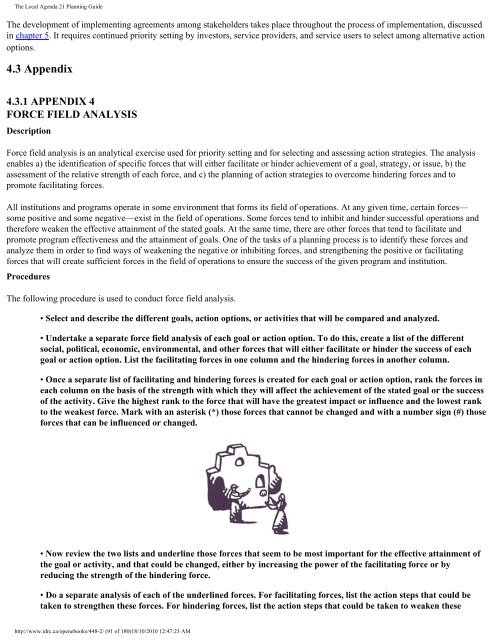The Local Agenda 21 Planning Guide - Democrats Against UN ...
The Local Agenda 21 Planning Guide - Democrats Against UN ...
The Local Agenda 21 Planning Guide - Democrats Against UN ...
You also want an ePaper? Increase the reach of your titles
YUMPU automatically turns print PDFs into web optimized ePapers that Google loves.
<strong>The</strong> <strong>Local</strong> <strong>Agenda</strong> <strong>21</strong> <strong>Planning</strong> <strong>Guide</strong><br />
<strong>The</strong> development of implementing agreements among stakeholders takes place throughout the process of implementation, discussed<br />
in chapter 5. It requires continued priority setting by investors, service providers, and service users to select among alternative action<br />
options.<br />
4.3 Appendix<br />
4.3.1 APPENDIX 4<br />
FORCE FIELD ANALYSIS<br />
Description<br />
Force field analysis is an analytical exercise used for priority setting and for selecting and assessing action strategies. <strong>The</strong> analysis<br />
enables a) the identification of specific forces that will either facilitate or hinder achievement of a goal, strategy, or issue, b) the<br />
assessment of the relative strength of each force, and c) the planning of action strategies to overcome hindering forces and to<br />
promote facilitating forces.<br />
All institutions and programs operate in some environment that forms its field of operations. At any given time, certain forces—<br />
some positive and some negative—exist in the field of operations. Some forces tend to inhibit and hinder successful operations and<br />
therefore weaken the effective attainment of the stated goals. At the same time, there are other forces that tend to facilitate and<br />
promote program effectiveness and the attainment of goals. One of the tasks of a planning process is to identify these forces and<br />
analyze them in order to find ways of weakening the negative or inhibiting forces, and strengthening the positive or facilitating<br />
forces that will create sufficient forces in the field of operations to ensure the success of the given program and institution.<br />
Procedures<br />
<strong>The</strong> following procedure is used to conduct force field analysis.<br />
• Select and describe the different goals, action options, or activities that will be compared and analyzed.<br />
• Undertake a separate force field analysis of each goal or action option. To do this, create a list of the different<br />
social, political, economic, environmental, and other forces that will either facilitate or hinder the success of each<br />
goal or action option. List the facilitating forces in one column and the hindering forces in another column.<br />
• Once a separate list of facilitating and hindering forces is created for each goal or action option, rank the forces in<br />
each column on the basis of the strength with which they will affect the achievement of the stated goal or the success<br />
of the activity. Give the highest rank to the force that will have the greatest impact or influence and the lowest rank<br />
to the weakest force. Mark with an asterisk (*) those forces that cannot be changed and with a number sign (#) those<br />
forces that can be influenced or changed.<br />
• Now review the two lists and underline those forces that seem to be most important for the effective attainment of<br />
the goal or activity, and that could be changed, either by increasing the power of the facilitating force or by<br />
reducing the strength of the hindering force.<br />
• Do a separate analysis of each of the underlined forces. For facilitating forces, list the action steps that could be<br />
taken to strengthen these forces. For hindering forces, list the action steps that could be taken to weaken these<br />
http://www.idrc.ca/openebooks/448-2/ (91 of 180)18/10/2010 12:47:23 AM










